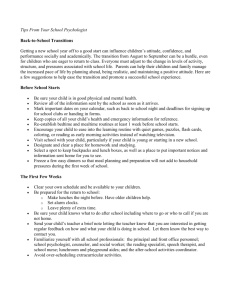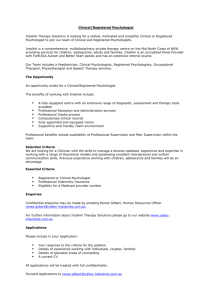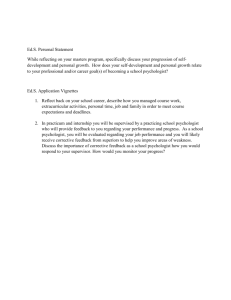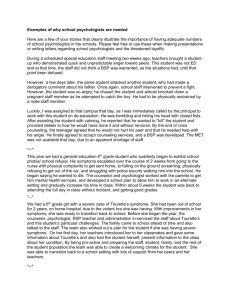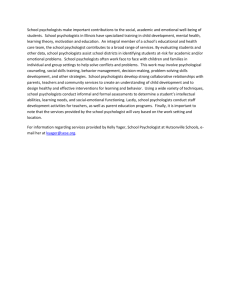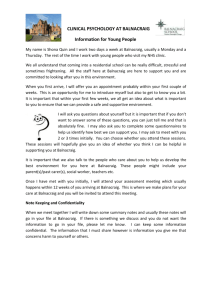WRITING FOR SCHOOL PUBLICATIONS
advertisement
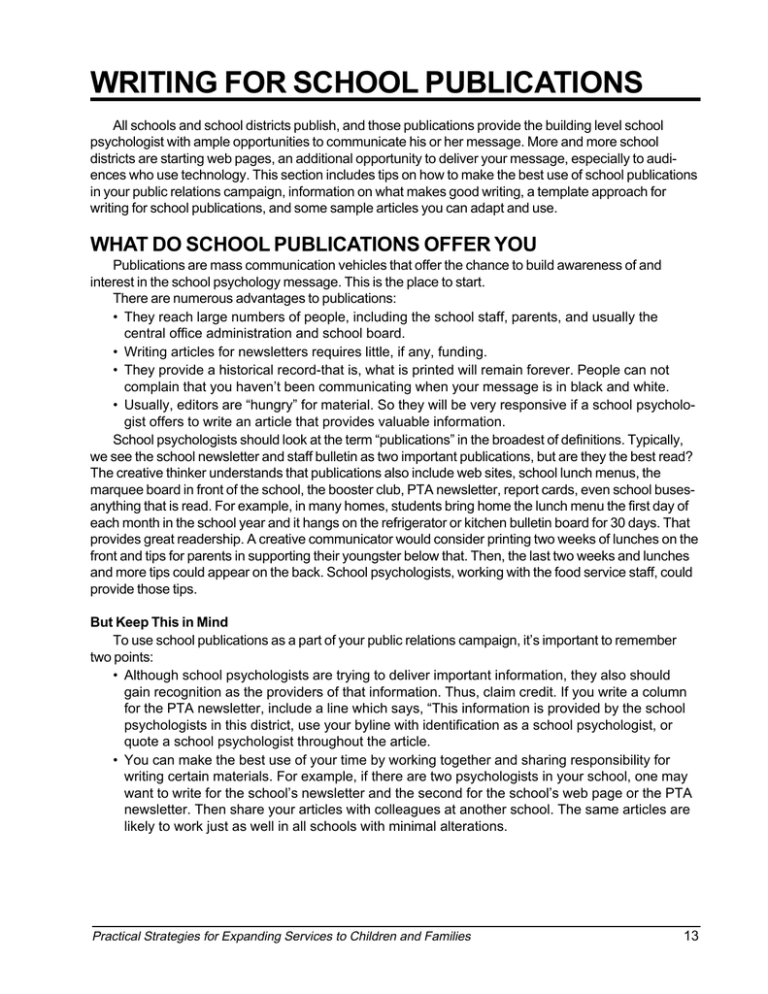
WRITING FOR SCHOOL PUBLICATIONS All schools and school districts publish, and those publications provide the building level school psychologist with ample opportunities to communicate his or her message. More and more school districts are starting web pages, an additional opportunity to deliver your message, especially to audiences who use technology. This section includes tips on how to make the best use of school publications in your public relations campaign, information on what makes good writing, a template approach for writing for school publications, and some sample articles you can adapt and use. WHAT DO SCHOOL PUBLICATIONS OFFER YOU Publications are mass communication vehicles that offer the chance to build awareness of and interest in the school psychology message. This is the place to start. There are numerous advantages to publications: • They reach large numbers of people, including the school staff, parents, and usually the central office administration and school board. • Writing articles for newsletters requires little, if any, funding. • They provide a historical record-that is, what is printed will remain forever. People can not complain that you haven’t been communicating when your message is in black and white. • Usually, editors are “hungry” for material. So they will be very responsive if a school psychologist offers to write an article that provides valuable information. School psychologists should look at the term “publications” in the broadest of definitions. Typically, we see the school newsletter and staff bulletin as two important publications, but are they the best read? The creative thinker understands that publications also include web sites, school lunch menus, the marquee board in front of the school, the booster club, PTA newsletter, report cards, even school busesanything that is read. For example, in many homes, students bring home the lunch menu the first day of each month in the school year and it hangs on the refrigerator or kitchen bulletin board for 30 days. That provides great readership. A creative communicator would consider printing two weeks of lunches on the front and tips for parents in supporting their youngster below that. Then, the last two weeks and lunches and more tips could appear on the back. School psychologists, working with the food service staff, could provide those tips. But Keep This in Mind To use school publications as a part of your public relations campaign, it’s important to remember two points: • Although school psychologists are trying to deliver important information, they also should gain recognition as the providers of that information. Thus, claim credit. If you write a column for the PTA newsletter, include a line which says, “This information is provided by the school psychologists in this district, use your byline with identification as a school psychologist, or quote a school psychologist throughout the article. • You can make the best use of your time by working together and sharing responsibility for writing certain materials. For example, if there are two psychologists in your school, one may want to write for the school’s newsletter and the second for the school’s web page or the PTA newsletter. Then share your articles with colleagues at another school. The same articles are likely to work just as well in all schools with minimal alterations. Practical Strategies for Expanding Services to Children and Families 13 REMEMBER YOUR GREAT NASP RESOURCES There is no need to develop new information for articles when high quality information is already available. NASP’s publication Helping Children at Home and School: Handouts from Your School Psychologist has tremendous material on important issues. Just about every handout has information parents, teachers and school administrators should know. Also Best Practices III and Children’s Needs II are excellent resources for developing handouts, talks, or articles. KEYS TO EFFECTIVE WRITING When writing for school publications, it’s always best to remember what goes into good writing. With the short attention spans and numerous commitments many people have today, they simply aren’t going to take the time to plow through poorly written material. You are competing for their attention. Here are some tips that have worked for school PR practitioners around the country: • Be as brief as possible. Never use two words to say what can be said in one; never use a foursyllable word when a one-syllable word works just as well. Brevity is essential because people have such a limited amount of time for any activity, including reading a news article or your memo. Look at how successful USA TODAY has been. • Use short sentences and short paragraphs. While your high school English teacher may have suggested a topic sentence followed by 15 additional sentences in the paragraph to develop that thought, two, three or four sentences work just fine. • Use the active voice and especially active verbs. Writing should be crisp, active, easy to understand, and quick-moving. • Adjectives and adverbs don’t always add essential information to writing. Stay away from “double adjectives.” For example, it doesn’t add anything to write “an essential and necessary step in school reform.” If something is essential, it’s necessary. • Always read your writing with a critical eye and sharp pencil after you draft it. Your intent should be to eliminate every word or phase that doesn’t add important information to your writing. • Just as you should stay away from educational jargon, forget abbreviations. In education, we seem to rely upon abbreviations. Don’t, especially when communicating to a general audience. EDUCATORS CAN’T MAKE MISTAKES One can frequently find mistakes in publications from government officials and corporate leaders, and somehow that seems to be accepted. It’s a different case when educators slip up. We are teaching children and are supposed to know how to spell. Our mistakes provide ammunition to our critics. Thus, it is essential that we do everything possible to eliminate grammatical errors, misspelled words and inaccurate punctuation. Keep in mind that you can’t simply do a quick “spell check” on your computer. Read and edit your writing very carefully. 14 Practical Strategies for Expanding Services to Children and Families THE TEMPLATE APPROACH Writing the school psychologist’s message can be easily done when you become familiar with the NASP publication, Helping Children at Home and School: Handouts from Your School Psychologist. These numerous handouts provide ample material to plug into an article for a school newsletter or web site, a staff bulletin, or a PTA newsletter. Consider these examples: For Parents • Parent -Teacher Meetings (pg. 77) • Household Chores for Children (pg. 25) • Homework Survival Guide (pg. 65) For Teachers • Anger Management for Young Children (pg. 301) • Depression in Children (pg. 241) • Academic Motivation (pg. 135) And there are many, many more that can be adapted into an article that people will value. When preparing your article, include three elements: 1. An introductory paragraph which communicates the importance of the topic and the value of the parent or other individual being involved in that topic 2. Several things that individual can do 3. Ways to obtain more information The following demonstrates how that approach would work for an article geared for parents on using household chores as a learning experience for children. (Introductory paragraph) Household chores can teach young children behaviors that are important to success in school and later in life, such as responsibility and meeting deadlines, according to Jane Smith, a school psychologist at Sunnyside Elementary School. Parents can provide important lessons in their home can assign chores and supervise them as learning experiences. (Ideas to use) Here are nine tips for parents who want to use chores as a learning experience: use the bulleted list from page 26 in Helping Children at Home and School. (Ways to obtain more information) For more information on how to use household chores to help young children, contact Smith at Sunnyside Elementary, phone number. SAMPLES The four examples that follow can be adapted for your communications activities. Practical Strategies for Expanding Services to Children and Families 15 Classroom Consequences By________________, School Psychologist Once your classroom rules are developed, you must also set up disciplinary consequences for the students who choose not to follow the rules. This teaches students they are responsible for their actions and that they have a choice. If they choose to follow the rules, then they are rewarded. However, if they choose to disobey, then a disciplinary consequence should immediately follow. Here are some tips to develop effective disciplinary consequences: 1. Be prepared ahead of time. The more prepared you are, the more effective we can be. 2. Choose consequences that you are comfortable using. For some teachers, after school detention would not be as comfortable as time-out within the classroom day. 3. The consequences must be something the children do not like, but are not harmful to them either physically or psychologically. 4. Consequences must comply with school board policy and be acceptable to your principal. 5. Be sure to let parents know what your consequences are. 6. Consequences should be provided to the child as a choice. That allows the child an opportunity to behave appropriately. 7. Your delivery of the consequence is important. Stay cool, calm – yet firm. If you lose control, the consequence will lose its power. 8. Never take away a consequence once you have given it. 9. List consequences in a hierarchal manner from least to most severe. Contact with the principal and / or parents should be towards the end of you hierarchy. 10. If consistent use of the consequence doesn’t stop the misbehavior, it is not tough enough. 11. Start each day with a clean slate. That gives students a chance to start out on the right foot. 12. Remember that you must balance your consequence with praise and other positives. The more positive you are with children, the less you will need to discipline. This article was adapted with permission from material supplied by the Communiqué, a publication of the National Association of School Psychologists. [This article was written by Kathi Armstrong, who writes a column called “School Psychologist’s Corner” which appears in the Bulletin, a monthly newsletter published by the Bay District School System in Bay County, Florida. The article is appropriate for a staff or teacher newsletter.] 16 Practical Strategies for Expanding Services to Children and Families Effective Problem Solving By ______________, School Psychologist Much of our time and energy is devoted to problem-solving and decision-making. A problem is defined as any situation for which we don’t have a ready, immediate, response. A solution requires applying an idea that we believe will work to diminish a problem. A decision is the choice we make from among alternative ideas or possible solutions. We all experience problems in our daily lives. These fall into the areas of getting along with friends, dealing with peer pressure, respecting authority and limits set by teachers and parents, and planning form life after high school. Most of us could use some help in improving our problem solving skills. Some common pitfalls to good decision-making include ignoring a problem, hoping that it will just go away, procrastinating making a decision, or “passing the buck” and hoping someone else will solve the problem for us. Unfortunately, most problems don’t go away without acting. Putting off a decision often makes a problem worse, and relying on others to solve your problem for you may not result in what is really right for you. Here are some suggestions to help improve your problem-solving skills: Believe in yourself. It is helpful to be optimistic about your ability to make decisions. Your must trust your instinct. Review past solutions for present problems. If a certain solution has worked in the past, by all means use it again. If a certain solution has failed in the past, choose a different alternative this time. Recognize that most problems do not have perfect solutions. Many decisions we make have positive and negative aspects. It is very rare that there is a single, best solution to problems in daily living. Review the pros and cons of potential decisions. It can be helpful to write down a list of possible decisions, considering the advantages and disadvantages of each before selecting a solution. This will help you avoid selecting the first solution that comes to mind. It will force you to anticipate possible consequences of your decision. Seek help from friends, a school psychologist, counselor or other mental health profes sional if your are having trouble making a big decision. Sometimes other people can see possible solutions that you have not considered. They can tell you about what may have worked for them or they can encourage you to consider trying an alternative you may not have thought of yourself. If you feel like you need some assistance in addressing a difficult problem you can contact (insert appropriate names and titles) at (given accompanying phone numbers or office locations). This article was adapted with permission from material supplied by the Communiqué, a publication of the National Association of School Psychologists. [This article was written by Robyn Finkenthal Ramsey and originally appeared in the Shield & Lance Volume 7, Number 4, a high school newspaper in Dekalf County, Georgia. Although originally written for high school students the article could easily be adapted for a variety of audiences.] Practical Strategies for Expanding Services to Children and Families 17 Helping Children Cope With Death By ____________, School Psychologist The loss of a parent, relative or close friend can be a disturbing experience for most children. Psychologists report that children are best able to cope with and assimilate these losses when they have been prepared, in an honest and caring manner to understand death as part of the life cycle. Children are far more capable of dealing with the loss of a parent, sibling, or friend if they not only receive ample love, comfort and support, but if they also are helped to understand the facts. It is without question a tough job to speak with-children about death and dying. Not to do so is to leave them unprotected from the pain and bewilderment that accompanies this inevitable experience. Children’s imaginations are so active that their fears and fantasies of death are often more disturbing than the reality. Children need to know how death occurs. They must understand that death results from real, physical causes – not from some malevolent spirit and above all not because the child misbehaved. Children also need to know about funerals and interment, so that these rites do not disturb them. These are useful things which adults can remember to say or do with children so they are better emotionally equipped to work through their feelings of loss and grief. Following are some useful guidelines for parents or teaches to keep in mind when working with children following the death of a family member or close friend. Discuss death in exact terms. People who die do not “pass away” or “ go to sleep” or are “lost”. “Passing” can become scary to a child who passes from grade to grade and “going to sleep” can turn bedtime into terror. Getting “lost” which is not uncommon among children becomes irreversible and erases the possibility of being found and reunited. Use the words “die” and “death.” If appropriate, arrange a parting visit in the case of a terminally ill parent or relative. Bidding farewell to a loved one is important and can become part of healing memories for children. Allow expressions of emotion / affect. When someone they loves dies, it is important to allow children to freely express their sorrow, lest unresolved grief follow them into adulthood. We all learn to mourn by experience shedding tears over dead pet or sharing the grief of friends when their loved ones have dies. Children can be helped to accept the loss by viewing pictures and mementos of the dead person and discussing their memories and feelings. Reassure children of your care. Children need to be reassured repeatedly that hey will be taken care of and not abandoned. Abandonment is a child’s greatest fear and children often incorporate death as a kind of desertion. They need liberal comfort and support. Children also need as much stability in their lives as circumstances permit. Be genuine yourself. Allow children to see you grieve and express emotions. If you struggle not to cry, children are likely to conclude that grief is to be borne in silence. Anger, denial, guilt and fear are all normal parts of grief. Children need to work through these feelings and there is great value in your appropriate self-disclosure. Children unable to cope with their grief provide signals in the form of significant changes in behavior. Prolonged depression, insistence that the death has not really occurred, sustained acting out of anger these pleas for help. Death is especially hard for children to accept if it comes by violence. Psychologists, social workers, trained clergy and other mental health workers who are familiar with such reactions may be worth turning to for professional counsel. (Include information about how the school psychologist and other mental health professionals can be contacted.) 18 Practical Strategies for Expanding Services to Children and Families With time and continuing reassurance from their parents and other members of the family children can emerge from a grieving period with healthy memories of a loved one. The loss experience can become assimilated into the fabric of their ongoing life and buttress future coping efforts in the event of trauma. Adults must help children realize that wrenching though death is — love, support and connectedness with caring others is still there. This article was adapted with permission from material supplied by the Communique, a publication of the National Association of School Psychologists. [Penny Peterson, who works for Montgomery County Public Schools in Maryland, wrote this article. The article is appropriate for a handout or newsletter for all parents and teachers who are dealing with grief issues with their children.] Practical Strategies for Expanding Services to Children and Families 19 Creating an Effective Classroom Environment By ____________, School Psychologist There are three major ingredients that go into creating an effective classroom environment. They are: • classroom management procedures • productive use of time • positive class climate Teachers who are aware of these factors and take them into account when organizing their classroom will create an environment where children enjoy learning. Classroom management includes establishment of rules, consequences and rewards. At the very beginning of the year, rules and routines are introduced and practiced. Teachers must clearly communicate what behavior will and will not be tolerated. Any disruptive behavior is immediately handled and students should experience the consequences of their misbehavior. At the same time, the teacher praises students for good behavior and is sure to build many positive incentives into the classroom. Productive use of time is also essential in creating an effective classroom environment. This includes organizing the physical space in the classroom and making supplies and materials accessible. Lessons are prepared in advance, including getting materials or other teaching aids ready. Students must also know what to do with their finished work and how to get help. Transition times must be carefully planned for, and made as short as possible. Care should be taken so that directions are clear, simple and concise, and often written on the board or paper to help students remember. Third, research shows that students learn more and behave better in a pleasant, happy classroom. Teachers should encourage and praise students for their efforts. Time is given for students to express their ideas and opinions and these are accepted in a non-judgmental way. The teacher is aware of individual differences and flexible in meeting those students’ needs. Cooperation with others rather than competition is reinforced, and students are reinforced for their positive interactions with others. “Catch them being good” will not only decrease behavior problems, but will also encourage appropriate classroom behavior. This article was adapted with permission from material supplied by the Communiqué, a publication of the National Association of School Psychologists. [This article was written by Kathi Armstrong, who writes a column called “School Psychologist’s Corner” which appears weekly in The Bulletin, a monthly newsletter published by the Bay District School System in Bay County, Florida. The article is appropriate for a staff or teacher newsletter.] 20 Practical Strategies for Expanding Services to Children and Families
